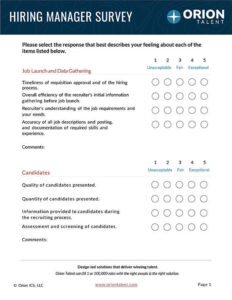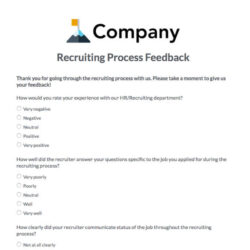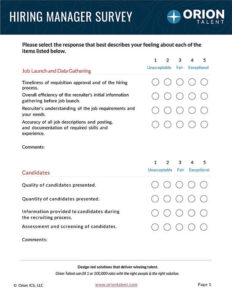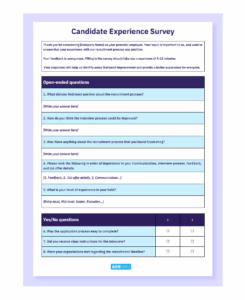Ever wondered if your hiring process truly hits the mark from the perspective of the people who actually bring new talent onboard? It’s easy for recruitment teams to focus on candidate experience and time-to-hire, but the satisfaction of your hiring managers is an equally critical piece of the puzzle. After all, they are the end-users of your recruiting efforts, and their insights are invaluable for refining your strategy and ensuring you’re delivering the right candidates efficiently.
Understanding their pain points, successes, and overall experience with the recruitment department can unlock significant improvements. This feedback loop is essential for building stronger partnerships between HR and the business units. A well-designed hiring manager satisfaction survey template can be your secret weapon, providing a structured way to gather actionable feedback and ensure everyone is aligned on what successful hiring truly looks like.
Crafting a Comprehensive Hiring Manager Feedback Tool
When you’re looking to understand how effective your recruitment efforts are, asking the right questions is paramount. A comprehensive hiring manager satisfaction survey isn’t just a formality; it’s a strategic tool that allows your organization to pinpoint strengths and weaknesses in the talent acquisition process. It helps you assess everything from the initial job requisition process to the quality of candidates presented, and even the efficiency of communication throughout the hiring journey. By regularly soliciting this feedback, you demonstrate a commitment to continuous improvement and a partnership approach with your internal stakeholders.
The core of a truly effective survey lies in its ability to cover all touchpoints a hiring manager experiences. Think about their journey: from the moment they identify a need for a new team member to the final onboarding of a successful hire. Each step offers an opportunity for improvement or confirmation of a well-executed process. You’ll want to dig into areas like the clarity of the job description drafting, the responsiveness of the recruiting team, the relevance of candidate pipelines, and how well new hires are prepared for their roles upon joining.
Key Question Categories to Include
To ensure you capture a holistic view, consider organizing your hiring manager satisfaction survey template around several key themes:
By asking specific questions within each of these categories, you gather data that goes beyond simple “satisfied” or “dissatisfied” responses. For instance, instead of just asking about “candidate quality,” you might ask, “How well did the candidates presented meet the essential skills requirements for the role?” or “How well did the candidates’ soft skills align with your team’s culture?” This level of detail provides actionable insights, helping you understand precisely where adjustments are needed, whether it’s refining candidate sourcing, improving screening processes, or enhancing internal communication protocols.
Leveraging Your Survey Results for Strategic Growth
Collecting feedback is only half the battle; the real value of a hiring manager satisfaction survey template comes from how you use the insights you gain. Once the data is in, it’s crucial to analyze it thoughtfully. Look for trends, common themes, and any significant outliers, both positive and negative. Are there particular recruiters who consistently receive high praise? Are certain departments consistently experiencing delays or challenges with candidate quality? Identifying these patterns will help you celebrate successes and pinpoint areas requiring focused attention and strategic intervention.
Consider the timing and frequency of your survey deployment as well. Sending a survey immediately after a hire is complete can capture fresh, relevant feedback, but a periodic survey (e.g., quarterly or bi-annually) can provide a broader view of ongoing satisfaction and trends over time. The goal is to make it easy and convenient for hiring managers to provide their input, ensuring a good response rate. Keep the survey concise, explain its purpose clearly, and assure anonymity where appropriate to encourage honest feedback.
Here are some best practices for survey deployment and analysis:
The final and perhaps most critical step is to act on the feedback. This means more than just acknowledging the results; it involves developing concrete action plans based on the insights gathered. If multiple managers express concerns about the initial screening process, perhaps it’s time to revisit the interview guides or recruiter training. If communication is a recurring issue, explore new tools or protocols for updates. Once changes are implemented, it’s equally important to communicate these improvements back to your hiring managers. Closing the feedback loop demonstrates that their input is valued and directly contributes to a more efficient and effective hiring ecosystem, strengthening their trust and partnership with the recruitment team.
By regularly deploying and thoughtfully acting upon the feedback from a robust survey, you transform your recruitment function into a truly collaborative partner for your organization. This proactive approach not only resolves immediate challenges but also cultivates a continuous cycle of improvement, ensuring that the talent acquisition process consistently meets and exceeds the expectations of those on the front lines of building your teams.
Embracing the insights gained from your hiring managers ensures that your recruitment strategies are always aligned with the evolving needs of the business. It’s about building stronger internal relationships and making sure every hire is a step towards greater organizational success.



